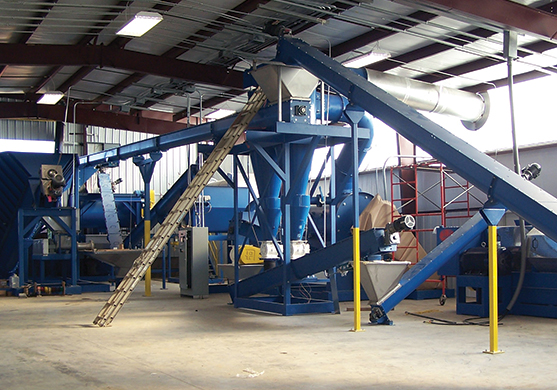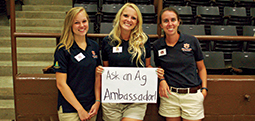| Current Issue | Past Issues | Subscribe | Ag Homepage |

In a Flash
Rendering Industry by
A patented Auburn University–developed process that cleanly converts inedible waste from the slaughter of animals into marketable products made its commercial debut this summer with the opening of Alabama Protein Products LLC at Kyser Family Farms, a catfish operation in Hale County.
Alabama Protein, which will ultimately employ five to 10 people and is expected to give the state’s catfish industry an economic boost, is the first private venture ever to use the trademarked Agricultural Byproduct Value Recovery System, or ABVRS, a quick, energy-efficient and environmentally sound rendering process that, as opposed to conventional rendering methods, creates no foul odors, toxic emissions or wastewater as it recycles animal tissue from food processing plants and other agricultural byproducts into both high-protein fish meal for use in poultry, livestock and fish feed and heart-healthy omega 3 fish oil.
“As it is now, it costs the Alabama catfish industry about $1 million a year to haul catfish offal from processors here to the catfish rendering plant in west Mississippi,” says Bill Kyser, College of Agriculture alumnus and patriarch of Kyser Farms. “The renderer pays the processor for the raw offal, but sometimes the freight is more than the offal is worth. If we keep the offal and process it here and make it more valuable, then our fish will be more valuable.”
The ABVRS differs significantly from the conventional rendering process, said Jesse Chappell, associate professor of fisheries and allied aquacultures at Auburn and lead researcher on the system.
“In traditional rendering, offal goes into giant vessels, where it’s basically cooked like a stew for a while to remove the water and separate the solids and the fats, and that’s where you get the strong smell that’s associated with rendering plants and the large volume of odorous, high-strength wastewater,” Chappell says. “The ABVRS uses high heat and relatively simple drying technologies that eliminate that whole cooking process and the environmental problems that come with it.”
In the new flash-dehydrating rendering system, high-fat, high-moisture slaughterhouse byproducts are ground and mixed with a compatible meal and loaded into the central processing unit, where air of 800 degrees Fahrenheit instantly evaporates 90 percent of the moisture and releases it into the atmosphere as clean, odor-free steam. From start to finish, the entire process of converting the inedible animal byproducts into valuable meal takes about 60 seconds.
The concept that would become the ABVRS originated in the mid-2000s with Birmingham businessman Ken Mosley, a 1971 Auburn business administration alumnus and a designer and manufacturer of wastewater treatment equipment. It was while working with west Alabama catfish processors to improve the methods for removing pollutants from the wastewater they produced that the idea of producing fish meal, not by cooking offal but by dehydrating it, came about. Mosley and his business partner, Rick Renninger, built a prototype of the basic system and contacted Chappell, whose research at Auburn focuses on improving efficiency and profitability in Alabama’s aquaculture industry and who accepted Mosley’s invitation to see the process firsthand.
“It was a novel idea and was, in my opinion, a workable technology that held a great deal of potential as an alternative to the conventional process,” Chappell says. “The process just needed to be refined and scientifically tested.”
Mosley released his invention to Auburn, and, funded in large part by a grant from Alabama catfish producers, Chappell initiated research at Auburn’s E.W. Shell Fisheries Center north of campus that would prove the system effective and efficient for rendering not only catfish offal but also whole fish, poultry offal, whole birds, hatchery waste, shrimp and crab shells and manure.
In 2010, Auburn was awarded a patent on the ABVRS and licensed the technology to Birmingham-based Falcon Protein Products Inc., a company Mosley and Renninger established to build, market and install the ABVRS process and equipment. A year later, Kyser, a leader in the catfish producers’ organization that funded Auburn’s research, bought exclusive rights to use the system for freshwater catfish in the U.S.
Kyser has agreements with two processors, Heartland Catfish and SouthFresh Catfish, to buy offal generated at their west Alabama plants. Given Alabama Protein’s proximity to the processing facilities, the raw materials will be fresh and the resulting fish meal will be top quality.
In recent months, the price for quality, high-protein fish meal has jumped from $250 per ton to more than $1,000 per ton.
That Alabama Protein is located adjacent to the Kyser family’s catfish farm is significant, Mosley says, in that ABVRS facilities can be built on farms, or catfish or poultry processors can build them on site.
“That means they retain ownership of the resulting meal and oil, which allows the offal to become a profit center instead of a costly disposal problem,” he says.
Chappell predicted the Kysers’ Alabama Protein Products, could “revolutionize how byproducts from catfish and other meat processing plants are handled, in Alabama and the world.”
In mid-June, Falcon Protein officially partnered with a Grafton, Ill.–based plant that by year’s end will be processing invasive Asian carp culled from the Mississippi and Illinois rivers. Using the ABVRS technology, Falcon will recycle the waste products into fish meal and fish oil.
September 2012
Ag Illustrated

Cultivating the Cream of the Crop
College of Ag’s Best Assets—Its People by







